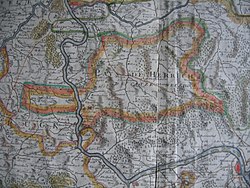
Katzenelnbogen is the name of a castle and small town in the district of Rhein-Lahn-Kreis in Rhineland-Palatinate, Germany. Katzenelnbogen is the seat of the Verbandsgemeinde Aar-Einrich.
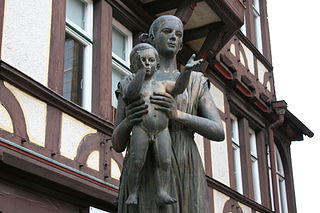
Henry I of Hesse "the Child" was the first Landgrave of Hesse. He was the son of Henry II, Duke of Brabant and Sophie of Thuringia.

Zwingenberg lies in the Bergstraße district in southern Hessen, Germany, south of Frankfurt and Darmstadt, and with the granting of town rights coming in 1274 it is the oldest town on the Hessen Bergstraße.

Sankt Goar is a town on the west bank of the Middle Rhine in the Rhein-Hunsrück-Kreis (district) in Rhineland-Palatinate, Germany. It belongs to the Verbandsgemeinde Hunsrück-Mittelrhein, whose seat is in Emmelshausen.

Auerbach Castle is one of several fortresses along the Bergstrasse in southern Hesse, Germany. The castle was originally built by King Charlemagne and rebuilt by Count Diether IV of the Katzenelnbogen dynasty in the second quarter of the 13th century. Today it remains standing atop a hill known as Urberg above the town of Bensheim-Auerbach.

Philip II of Hesse-Rheinfels, also called Philip the Younger, was the first Landgrave of Hesse-Rheinfels.

Countess Anne of Nassau-Siegen, German: Anne Gräfin von Nassau-Siegen, official titles: Gräfin zu Nassau, Vianden und Diez, Frau zu Breda, was a countess from the House of Nassau-Siegen, a cadet branch of the Ottonian Line of the House of Nassau, and through marriage successively Duchess of Brunswick-Lüneburg and Countess of Katzenelnbogen. She acted as regent of the Duchy of Brunswick-Lüneburg for her son in the period 1479–1486.

The Landgraviate of Hesse-Darmstadt was a State of the Holy Roman Empire, ruled by a younger branch of the House of Hesse. It was formed in 1567 following the division of the Landgraviate of Hesse among the four sons of Landgrave Philip I.

The Landgraviate of Hesse was a principality of the Holy Roman Empire. It existed as a single entity from 1264 to 1567, when it was divided among the sons of Philip I, Landgrave of Hesse.

Hesse-Rheinfels was created as a cadet line of Hesse for Philip II, Landgrave of Hesse-Rheinfels (1541–1583), landgrave from 1567 until 1583, and as a cadet line of Hesse-Kassel for Ernest, Landgrave of Hesse-Rheinfels (1623–1693), landgrave from 1627 until 1658.
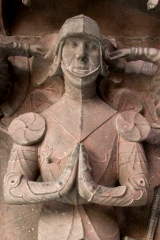
Henry III, Landgrave of Upper Hesse, called "the Rich" was the second son of Louis I of Hesse and his wife Anna of Saxony.

Ottilie of Katzenelnbogen, was by marriage Margravine of Baden-Baden.

Philipp I of Katzenelnbogen (1402–1479), also known "Philipp the Elder" was Count of Katzenelnbogen from 1444 to 1479 and was the last male descendant of the Counts of Katzenelnbogen. His parents were Johann IV, Count of Katzenelnbogen and Anne of Katzenelnbogen, who merged the two lines of the family back together in 1402.

Mathilde of Hesse was a Landrave princess from birth and became the Duchess of Cleves and Countess of La Marck through her marriage to John II, Duke of Cleves in 1489 until her death. She was the daughter of Henry III, Landgrave of Upper Hesse (1441-1483) and his wife Anna of Katzenelnbogen (1443-1494). She is notable for being the grandmother to Anne of Cleves the fourth wife of King Henry VIII of England.
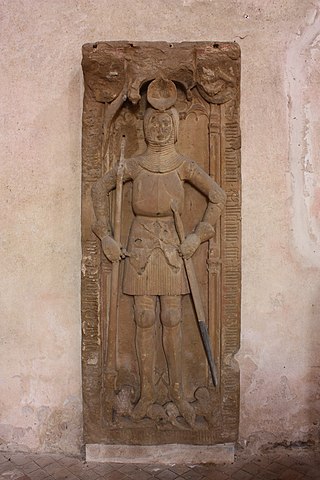
Johann IV, Count of Katzenelnbogen was one of the last members of the younger line of the House of Katzenelnbogen. He ruled the reunited County of Katzenelnbogen.
Diether VIII, Count of Katzenelnbogen was a Count from the younger line of the House of Katzenelnbogen. He ruled in Upper Katzenelnbogen. In 1376 he took part in the coronation of King Wenceslaus IV of Bohemia, as King of Germany.
Wilhelm I, Count of Katzenelnbogen was a Count from the elder line of the House of Katzenelnbogen. He ruled Lower Katzenelnbogen from 1276 to 1331. Wilhelm was the son of Diether V of Katzenelnbogen and Margaret of Jülich, daughter of William IV of Jülich.
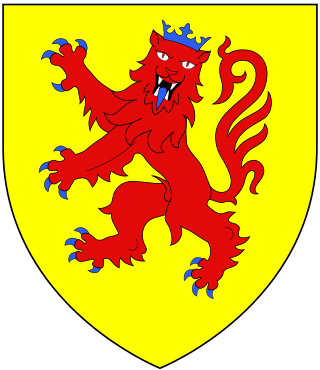
Anna of Katzenelnbogen was the daughter of Philipp I, Count of Katzenelnbogen (1402–1479), and his first wife Anna of Württemberg (1408–1471). She is notable for being the great-grandmother to Anne of Cleves the fourth wife of King Henry VIII of England.
